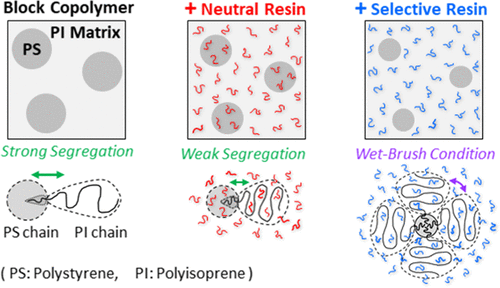当前位置:
X-MOL 学术
›
ACS Appl. Polym. Mater.
›
论文详情
Our official English website, www.x-mol.net, welcomes your
feedback! (Note: you will need to create a separate account there.)
Effects of Solubility Difference of Tackifier to Respective Components of Block Copolymers on Microphase-Separated Structures in Coated Layers of Pressure-Sensitive Adhesive Prepared by Solution Coating Process
ACS Applied Polymer Materials ( IF 4.4 ) Pub Date : 2020-09-30 , DOI: 10.1021/acsapm.0c00845 Takahiro Doi 1 , Hideaki Takagi 2 , Nobutaka Shimizu 2 , Noriyuki Igarashi 2 , Shinichi Sakurai 3
ACS Applied Polymer Materials ( IF 4.4 ) Pub Date : 2020-09-30 , DOI: 10.1021/acsapm.0c00845 Takahiro Doi 1 , Hideaki Takagi 2 , Nobutaka Shimizu 2 , Noriyuki Igarashi 2 , Shinichi Sakurai 3
Affiliation

|
Effects of solubility difference of tackifier to respective components of block copolymers on microphase-separated structures were examined using coated layers of the polystyrene-block-polyisoprene-block-polystyrene triblock copolymer and polystyrene-block-polyisoprene diblock copolymer blend, which forms spherical microdomains of polystyrene (PS) in the polyisoprene (PI) matrix, mixed with three types of tackifiers: aliphatic (C5) resin, aliphatic–aromatic (C5–C9) resin, and rosin ester (RE) resin. We performed small-angle X-ray scattering (SAXS) measurements to evaluate d spacing of the (110) planes of body-centered cubic (bcc) lattice and the average radius (R) of the PS spheres. Then, it was found that both d and R decreased with an increase in the tackifier content for all types of tackifiers. This decreasing tendency can be explained by considering that the added tackifier plays the role of solvent to swell the PI block chains to meet the wet-brush condition, resulting in a decrease in the aggregation number of the PS chains in a sphere. Thus, the PS sphere is smaller compared to the case without tackifier. The volume fraction of PS calculated from d and R values by assuming the bcc lattice was decreased with the tackifier content for the case of C5 and C5–C9 resins, while it was constant for the case of the RE resin. These results ensure that the RE resin plays the role of the neutral solvent while the other tackifiers play roles of PI-selective solvent. To discuss the long-term durability of nanostructures, gradual temporal changes in the nanostructures were also examined up to 30 days at 50 °C. As a consequence, the specimen mixed with the RE resin is considered to be suitable because the change in the nanostructures was the least for this case.
中文翻译:

增粘剂对嵌段共聚物各组分的溶解度差异对溶液涂布法制备压敏胶涂层中微相分离结构的影响
使用聚苯乙烯的涂覆层检测到微相分离结构的嵌段共聚物的各成分的增粘剂的溶解度差的影响块-polyisoprene-嵌段-聚苯乙烯三嵌段共聚物和聚苯乙烯-块-聚异戊二烯二嵌段共聚物混合物,其形成的球形微区聚异戊二烯(PI)基质中的聚苯乙烯(PS),与三种增粘剂混合:脂肪族(C5)树脂,脂肪族-芳香族(C5-C9)树脂和松香酯(RE)树脂。我们进行了小角度X射线散射(SAXS)测量,以评估以人体为中心的立方(bcc)晶格的(110)平面的d间距和平均半径(R)的PS领域。然后,发现对于所有类型的增粘剂,d和R均随着增粘剂含量的增加而降低。可以通过考虑添加的增粘剂起到溶剂的作用来溶胀PI嵌段链以满足湿刷条件,从而导致球体PS链的聚集数量减少,从而解释这种下降趋势。因此,与没有增粘剂的情况相比,PS球体更小。从d和R计算出的PS的体积分数对于C5和C5-C9树脂,假定bcc晶格随增粘剂含量的增加而降低,而对于RE树脂则恒定。这些结果确保了RE树脂起中性溶剂的作用,而其他增粘剂起PI选择性溶剂的作用。为了讨论纳米结构的长期耐用性,还对纳米结构在50°C下长达30天的时间变化进行了检查。结果,与RE树脂混合的样品被认为是合适的,因为在这种情况下纳米结构的变化最小。
更新日期:2020-11-13
中文翻译:

增粘剂对嵌段共聚物各组分的溶解度差异对溶液涂布法制备压敏胶涂层中微相分离结构的影响
使用聚苯乙烯的涂覆层检测到微相分离结构的嵌段共聚物的各成分的增粘剂的溶解度差的影响块-polyisoprene-嵌段-聚苯乙烯三嵌段共聚物和聚苯乙烯-块-聚异戊二烯二嵌段共聚物混合物,其形成的球形微区聚异戊二烯(PI)基质中的聚苯乙烯(PS),与三种增粘剂混合:脂肪族(C5)树脂,脂肪族-芳香族(C5-C9)树脂和松香酯(RE)树脂。我们进行了小角度X射线散射(SAXS)测量,以评估以人体为中心的立方(bcc)晶格的(110)平面的d间距和平均半径(R)的PS领域。然后,发现对于所有类型的增粘剂,d和R均随着增粘剂含量的增加而降低。可以通过考虑添加的增粘剂起到溶剂的作用来溶胀PI嵌段链以满足湿刷条件,从而导致球体PS链的聚集数量减少,从而解释这种下降趋势。因此,与没有增粘剂的情况相比,PS球体更小。从d和R计算出的PS的体积分数对于C5和C5-C9树脂,假定bcc晶格随增粘剂含量的增加而降低,而对于RE树脂则恒定。这些结果确保了RE树脂起中性溶剂的作用,而其他增粘剂起PI选择性溶剂的作用。为了讨论纳米结构的长期耐用性,还对纳米结构在50°C下长达30天的时间变化进行了检查。结果,与RE树脂混合的样品被认为是合适的,因为在这种情况下纳米结构的变化最小。













































 京公网安备 11010802027423号
京公网安备 11010802027423号